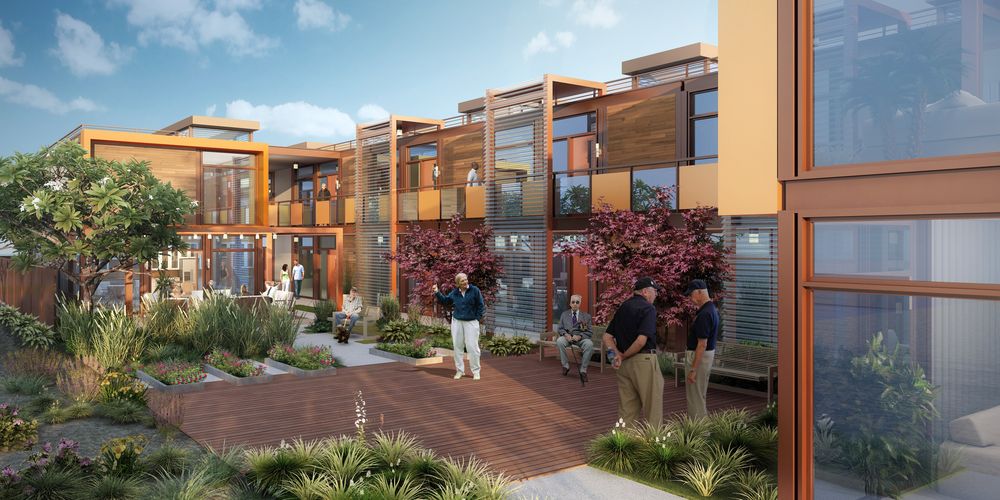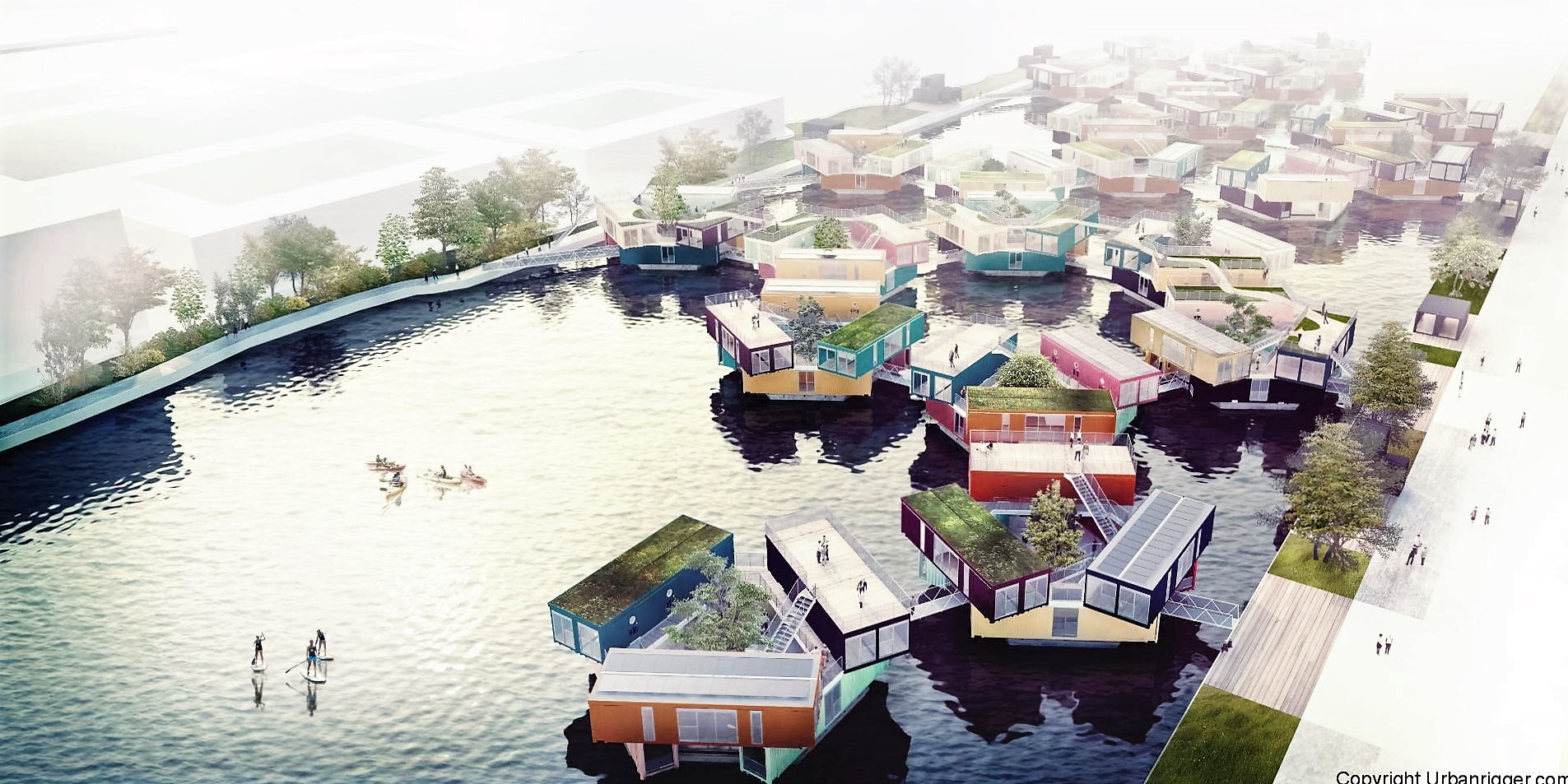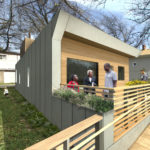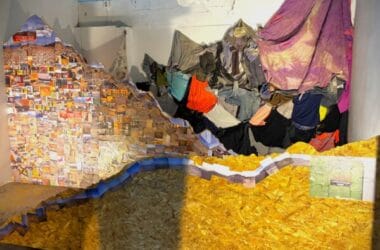Can re-purposed shipping containers become the next inexpensive, quick to construct, green building solution for affordable housing? Danish “starchitect” Bjarke Ingels, as well as a recent Orange County project, assert yes to all of the above, but there are limitations.


Housing Orange County’s homeless vets, three shipping containers apiece
By Doug Smith, Published in Los Angeles Times
The shipping container made one trip from Asia loaded with dry goods. From the harbor it was trucked to a small factory beside the Los Angeles River in Elysian Valley. There it made a 400-foot journey along an assembly line where more than 40 workers cut, welded, wrenched and nailed until it emerged eight days later with wallboard, windows, electrical and plumbing.
On September 21, encased in shrink wrap, the container was unloaded from a truck onto a vacant lot in Orange County, one of 54 prefabricated modules that will arrive over the next two weeks. They will be joined three to a unit and stacked to form a two-story, 16-unit apartment building for homeless veterans.
Over the decades, the goal of housing homeless people quickly and cheaply has spawned desperate ideas: tent cities, geodesic domes and micro shacks. All have proved to be neither permanent nor palatable.
Now an Orange County nonprofit is hoping that used shipping containers can provide shelter that is quick and economical but also permanent and homelike. American Family Housing, a nonprofit that builds housing and provides services for the homeless, is creating California’s first shipping-container apartment building.
The project comes at a time when the number of homeless people in Orange County is estimated at more than 15,000, up from fewer than 13,000 two years ago. Growing homeless encampments in the Santa Ana civic center and along the banks of the Santa Ana River have raised a public outcry.
Though the project, called Potter’s Lane, will admittedly serve only a tiny portion of that need, American Family Housing’s chief executive, Donna Gallup, expects it to inspire many others. With a modern wood-and-glass facade designed by SVA Architects, the structure will reveal little of its origin in the graveyard of shipping containers at L.A. Harbor.
“We are not putting people in shipping containers,” Gallup said. “We are putting them in housing — very energy-efficient, very structurally strong, very beautiful multifamily housing. It happens to be that the materials that will build that housing are shipping containers.”
Modifying shipping containers to house homeless people seems like a natural. The raw materials are plentiful, with tens of thousands of idle containers stacked at the port. The turnaround can be quick, and, despite their humble origins, containers can be fashioned into pleasant living spaces.
Sustainability can’t be like some sort of a moral sacrifice or political dilemma or a philanthropical cause. It has to be a design challenge. — Bjarke Ingels
STORY: How to Legalize Building and Living in Tiny Houses
httpvh://youtu.be/hvooM1PqDQ8
The design startup Urban Rigger, joined with architecture-phenom Bjarke Ingels of the firm BIG, has created a shipping container village floating on small barges off the coast of Copenhagen, Denmark. By stacking containers in two staggered triangles, the designers create an open-air courtyard in the center, and use the tops of the second level for a deck, a small lawn, and a solar array, Furthermore, they use a heat-exchange system from the water’s thermal mass to heat and cool themselves. Interiors are insulated by a NASA-developed technology.
The potential was demonstrated in the wars in Iraq and Afghanistan. U.S. contractors working for the U.S. Army Corps of Engineers have built hundreds of shipping-container residences in the two countries to billet U.S. personnel. For war-zone accommodations, they are surprisingly homey, but neither aesthetic nor meant to be permanent.
In contrast, the subsidies and tax credits that fund housing for the homeless require the projects to be viable for decades. Among the drawbacks that have discouraged developers is that containers are not designed for the stress of multistory construction.


American Family Housing is collaborating on the Potter’s Lane project with a Los Angeles manufacturing company, GrowthPoint Structures, which developed a proprietary solution for the structural weakness.
GrowthPoint, which also builds classrooms from containers, has obtained approval of its modular system for multifamily construction from the California Department of Housing and Community Development. The approval, a first, will allow Growth Point to build in any community without review of the modules by local building officials.
httpvh://youtu.be/pnYm4J2vmB4
Stacked cargo containers in New Haven, Connecticut’s “LEGO” apartments
Gallup said she embraced the system in the hope of pioneering faster, less costly housing that could be replicated across the region. “Imagine a 16-unit project is being created in the factory in just over three months,” she said. The project, which obtained site approval last December, has taken longer than planned, but not because of construction.
The holdup was getting the property, a vacant lot next to American Family Housing’s Midway City headquarters, through the local approval process. Even so, if the project opens on schedule in January, it would be less than six months after groundbreaking, unusually fast for a 16-unit apartment project. And Gallup believes that the steel construction will far outlast wood framing.
“We want to put people in a beautiful home that for the long term of this agency, long after I am gone, will still be here,” she said. There is such a glut of containers that GrowthPoint’s buyer can have the pick of those that have made only one trip. Identification numbers allow verification that no toxic cargo was inside.
Efforts to shelter homeless people have taken some unusual turns in Los Angeles over the decades. In the past, quick fixes for the homeless have mostly been impermanent by nature. To make a statement, homeless advocates erected a tent city next to City Hall during the 1984 holiday season. It was quickly dismantled but spawned other tent cities.
Homeless advocate Ted Hayes soon organized Justiceville, a village of plywood, cardboard and discarded items in a downtown park. Police shut it. The following year, Hayes was back with a new, city-approved tent city across from City Hall. It was later shut down for lack of insurance.
In 1987 the city created a 12-acre urban campground on the east side of downtown. It attracted about 500 individuals and families. Always intended as temporary, it was phased out within a couple of months and judged by one homeless advocate as “a hasty aberration, never to be repeated.”
By the early 1990s, Hayes was back, with a grant from Arco to build Genesis I, a village of 18 geodesic domes on a downtown parking lot. It survived more than a decade as a self-run homeless village before a rent increase forced it to close.
A Bay Area builder said he is soon to unveil a container-like housing module he calls the MicroPAD. In contrast to Potter’s Lane, each unit would be a single container — only 160 square feet — and they would be stacked as high as five stories in a honeycomb arrangement.


Gallup said she welcomes any innovative effort to provide more housing but questions whether large clusters of tiny units are the best answer for homeless people and would be well-received in Southern California.
Each unit in Potters Lane will be made from three containers, each measuring 8 feet wide by 20 long, totaling 480 square feet. There will also be a common area of three containers and offices for staff to support the clients.
“For us, the most important thing is that nobody is living in a shipping container,“ Gallup said. “You see shipping containers, they look like shipping containers. That’s not something you want in your community.”
Senior Los Angeles Times writer Doug Smith scouts Los Angeles for the ragged edges where public policy meets real people, combining data analysis and gumshoe reporting to tell L.A. stories through his 45 years of experience covering the city.













Pingback: How Cities Can Build Affordable Housing | WilderUtopia.com
LOVE YOUR BLOG, PLEASE INCLUDE ME TO RECEIVE NEWSLETTERS!